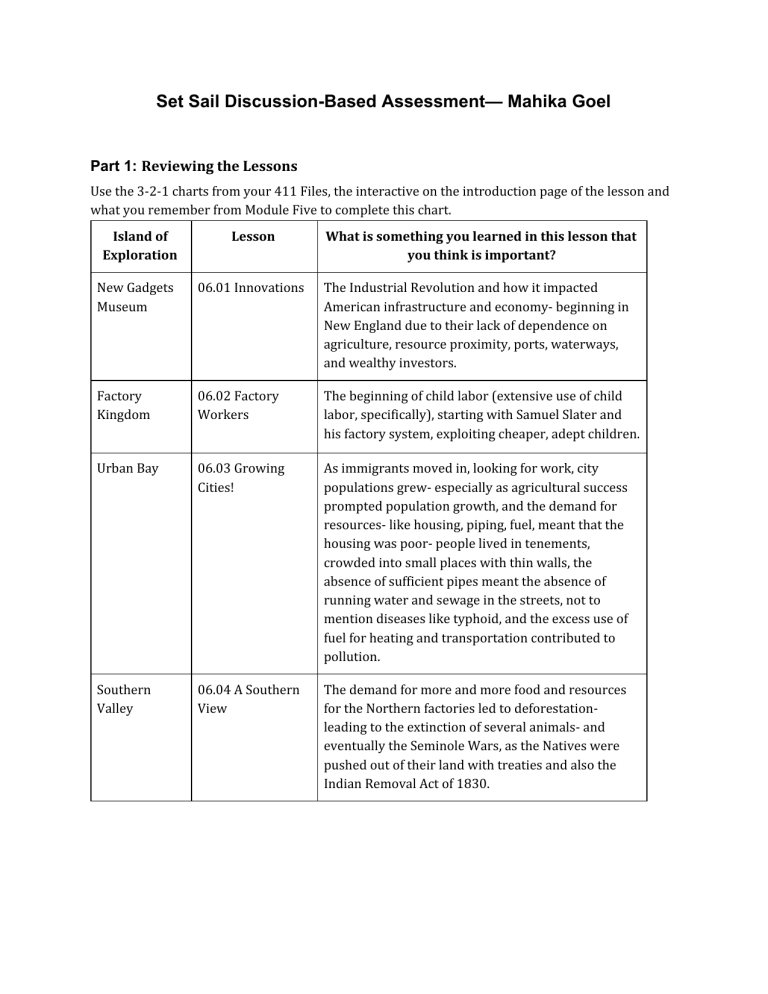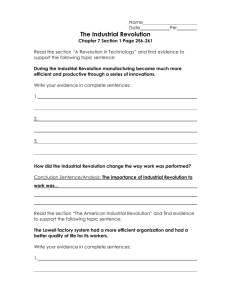
Set Sail Discussion-Based Assessment— Mahika Goel Part 1: Reviewing the Lessons Use the 3-2-1 charts from your 411 Files, the interactive on the introduction page of the lesson and what you remember from Module Five to complete this chart. Island of Exploration Lesson What is something you learned in this lesson that you think is important? New Gadgets Museum 06.01 Innovations The Industrial Revolution and how it impacted American infrastructure and economy- beginning in New England due to their lack of dependence on agriculture, resource proximity, ports, waterways, and wealthy investors. Factory Kingdom 06.02 Factory Workers The beginning of child labor (extensive use of child labor, specifically), starting with Samuel Slater and his factory system, exploiting cheaper, adept children. Urban Bay 06.03 Growing Cities! As immigrants moved in, looking for work, city populations grew- especially as agricultural success prompted population growth, and the demand for resources- like housing, piping, fuel, meant that the housing was poor- people lived in tenements, crowded into small places with thin walls, the absence of sufficient pipes meant the absence of running water and sewage in the streets, not to mention diseases like typhoid, and the excess use of fuel for heating and transportation contributed to pollution. Southern Valley 06.04 A Southern View The demand for more and more food and resources for the Northern factories led to deforestationleading to the extinction of several animals- and eventually the Seminole Wars, as the Natives were pushed out of their land with treaties and also the Indian Removal Act of 1830. Jackson Mountain 06.05 Jacksonian Democracy The ‘Jacksonian Era’- the age of the common man, where President Jackson upheld his strict beliefs as per his party’s, and faced many issues concerning tariffs, the national bank, supreme court cases, and slavery. Economic Harbor 06.06 War on the Bank! The two important cases in the history of the Supreme Court- McCulloch vs. Maryland and Gibbons vs. Ogden and how they forever impacted relationships and responsibilities of the national vs. state governments. Part 2: Making Connections Use the 3-2-1 charts from your 411 Files, the interactive on the introduction page of the lesson and what you remember from Module Three to complete this chart. Question Response How did the Industrial Revolution begin? Why did the Industrial Revolution start in New England? It started in New England because the farmers could not have successful farms because of the climate, so they turned to working in factories. The abundance of resources like coal and iron promoted industrialization, as well as the availability of ports, and streams and rivers for transportation and energy. The wealthy investors in the area also promoted the revolution, as they invested in factories and projects. How did Samuel Slater, Eli Whitney and Francis Cabot Lowell impact the Industrial Revolution? Samuel Slater- He smuggled textile factory machines and ideas into the US to use in his own factory- using ideas like the assembly line production. Francis Cabot Lowell- Visited factories in England and made diagrams of the machines there and took them back to the US, expanding on Slater’s mill, and essentially put all the stages of making cloth in one factory. Eli Whitney- He invented the cotton gin, which allowed unskilled people to remove the seeds from the cotton efficiently, making cotton cheap and easy to make. Who worked in the factories? What was life like for child factory workers? The child workers were overworked and put in hazardous conditions, and were paid very less; since they were children, factory owners got away with giving them low wages for their intense work. Who were the “Lowell Girls”? The Lowell Girls were the young, unmarried women employed by Francis Cabot Lowell, making up 80% of his workforce, lured into the job by the prospect of independence and female companionship. How did the Industrial Revolution change cities? How does Philadelphia represent the changes cities underwent? Philadelphia exhibited the changes associated with the rapid industrialization, including- poor housing and piping, disease, cultural diversity, lack of resources, the increasing workforce, violence outbreaks due to frustration, poverty, the opening of charities-like the Southwark Soup Society, the evolution of transportation and public services. What were the negative effects of urbanization? Air pollution due to the increased use of coal as fuel, factory waste polluting the environment, piping issues causing uncontrolled sewage in the streets, causing diseases, and the overcrowded population promoting disease. How did life change in Florida throughout the 1800s? What’s the difference between renewable and non-renewable resources? What are examples of each? Renewable resources are resources that can’t run out- you can’t use them up- like sunlight or wind. Non-renewable resources appear in limited quantities on Earth and can take thousands of years to replenish- like coal or oil. Who are the Seminoles and Black Seminoles? The Seminoles were a tribe moved to Central Florida by the government, and the Black Seminoles were descendants of free or runaway slaves who formed communities with the Seminole Indians. What happened in the elections of 1824 and 1828? What were the differences between Democratic-Republicans and National Republicans? Democratic-Republicans (today’s Republicans) believed that a strong central government was a threat to individual rights, and believed in a strict reading of the constitution, and therefore disapproving of a National Bank, as the power to create one is not expressly written in the constitution, and also of the funding of internal improvements projects for individual states, because it isn’t national improvement and causes conflict and division. National Republicans (today’s Democrats) believed in a strong central government ensuring national unity, and also in a loose reading of the Constitution- open to interpretation- and so supported the National Bank, and internal improvement projects. Why was there a power struggle between the states and the federal government? Why is the case of McCulloch v. Maryland important? The ruling in favor of McCulloch established a precedent for federal and state relationships, and established approval for the idea of ‘implied powers’ in the Constitution, also establishing that the state cannot challenge the power of the federal government. Why is the case of Gibbons v. Ogden important? The ruling in favor of Gibbons again established a precedent, this time for Congress to have the ability to override a state law that is in conflict with federal law, and extended the definition of commerce to include navigation, also giving the federal government some control within and across state borders. How does the government influence the economy? It can impose tariffs, it is responsible for providing legal and social structures- like schools, it is also responsible for correcting the side effects of growth. It stabilizes the economy. The tariffs of 1828, 1832, and 1833 established the tariffs imposed by the federal government. The act of moving $10 million from the 2nd national bank to the state bank by President Jackson caused inflation, and the Coinage Act, forcing people to exchange their paper money for gold and silver caused an economic depression- the Panic of 1837.


